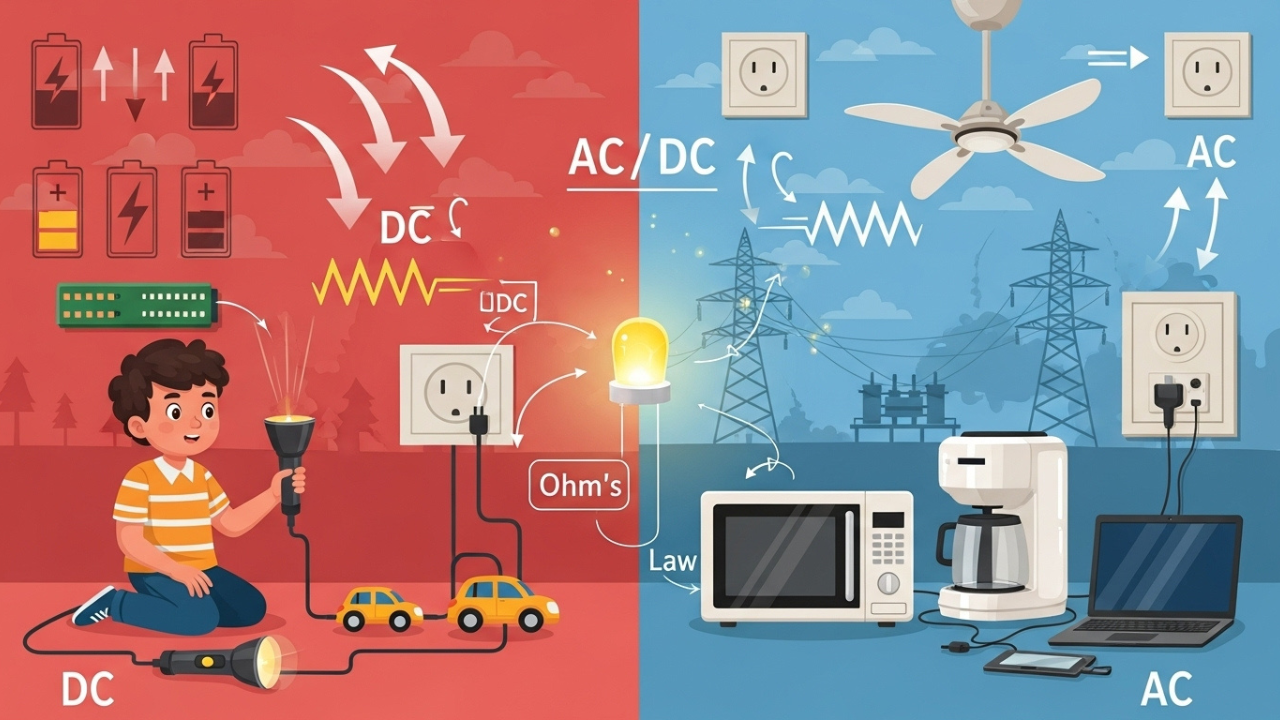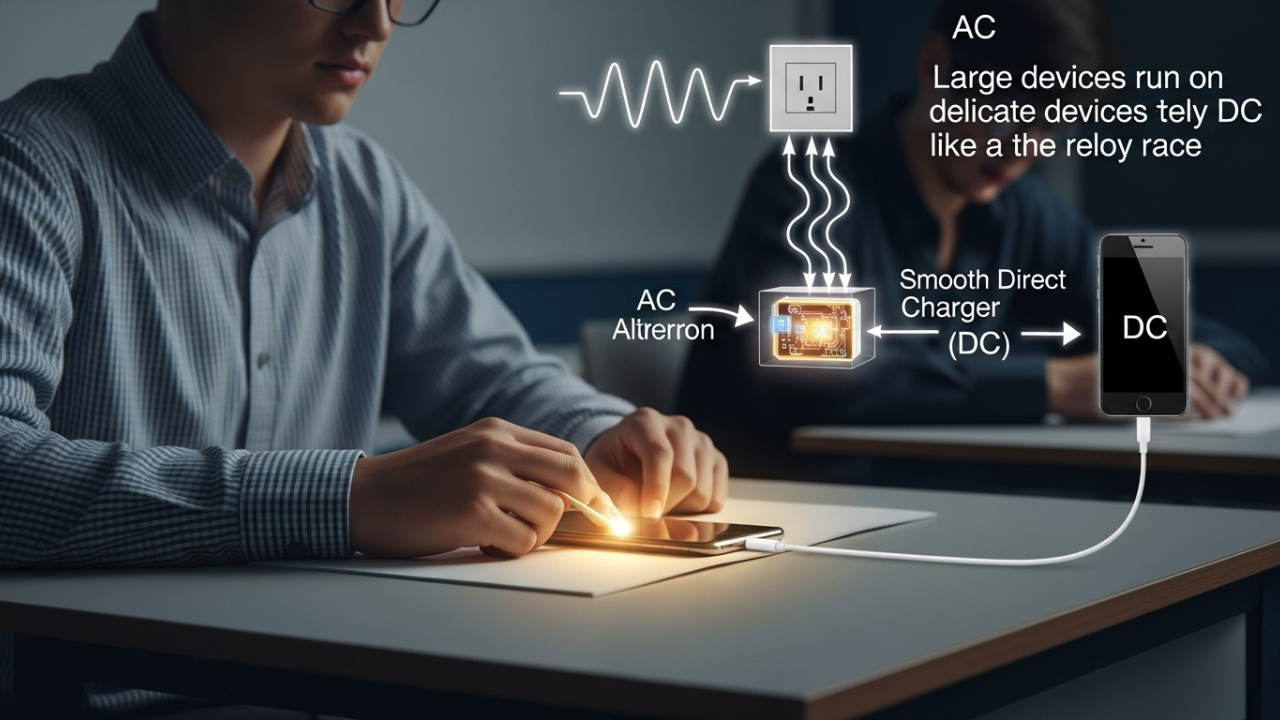Currently, how many of you plug your phones to charge? Almost all of you. But I also wonder, what happens when I plug in, and how will the phone detect that it’s charging?
The answer is more straightforward than it seems. The connection directs the phone to start charging. Everything enabling your device is powered on in perfect sequence with a single push of the button.
That is the modern world we live in. It is so complicated yet appears so simple, and effortless, creating no need to delve into the details of its workings.
In case you take my words seriously and don’t hesitate to pique your interest in the currents powering the devices, you are approaching the right conclusion. Great news: we are already here.
Indicating that, let us explicate the unfelt but omnipresent forces around you, like the energy station powering life around you: electric currants.
The great part is, I’m going to start with the most vital types of electric currents—naplier AC and DC atomic current. The even better part is how you won’t run into any unnecessary complexities.
Key Takeaways
- Electricity flowing in a straight line is what the common saying describes as a current or DC electric current. It’s used to type in identifiers of voltages (amperes).
- An AC alternating current where the switches are activated at breakneck speed control the power of appliances connected to a wall socket.
- Over long distances, technology dictates AC is preferred. While small devices like remotes opt for the opposite, DC.
- Chargers power phones and laptops by converting rotation current supplied through AC outlets to DC.
- Sift through the various models of technology with ease after being able to differentiate between their types
The Day I Realized All Electricity Isn’t the Same
Making note of all provided information during my science class was one of my strong suits. While my teacher made use of a remote in class, she claimed, “This teaches us about DC”. Stepping away from a ubiquitous discussion, let us focus on what really matters here. What did she mean? And what forms of current are we talking about? Obsessing about these questions led me to meticulously progress through the subject to find out.
Now to answer the “so what” behind this: she later wrote on the board marks that shaped my notion towards electronics for years to come. To those of you reading out there: if this piques even an ounce of interest, you’re in for a good journey.
What Electricity Really Is, In Words That Actually Make Sense
Electricity is not some mysterious force only scientists understand. Think of it as a bunch of tiny particles—electrons—flowing through a wire. Just like water flows through a pipe, electrons move through a wire, carrying energy from one place to another. That flow is what we call electric current. Without current, nothing powers on. Not your flashlight, not your video game console, not even your microwave popcorn. Now here’s the important part. Not all current flows the same way. Sometimes it goes in one direction and never changes. Other times, it moves back and forth many times per second. These are two different types of current, and they’re known as DC and AC.
What Direct Current Feels Like To Understand
Imagine water flowing through a straight pipe. You turn the tap on, and water comes out the other end, always in the same direction. That’s exactly how Direct Current, or DC, works. The electrons flow in one steady line from the negative end to the positive end. No twists, no turns, just a clean, straight route. Batteries are the best real-life example. When you put a battery in a toy, the current flows from one end to the other. That’s why DC is so useful in devices like flashlights, calculators, TV remotes, and your phone when it’s running on battery. It’s simple, reliable, and constant.
When You Plug Into The Wall, You’re Using AC
Let’s now take a step back. AC stands for Alternating Current, and it operates a little differently. Picture water not just flowing in one direction, but moving forward, backward, and forward again—rapidly switching sides in a continuous cycle.
This is what ‘alternating’ means. It is changing its flow direction multiple times every second. In fact, in most countries, this happens about 50 to 60 times per second. Electricity from wall sockets in your home and school is AC. Its capability to travel long distances makes it suitable for use in homes, schools, buildings, and even entire cities. When you toggle that light switch, you’re using AC.
The Way AC and DC Feel In The Real World
Imagine this scenario. You are in class and your phone is dead. You plug your phone in and a few moments later, it starts charging. But if the phone runs on DC and the charger gives out AC, then what’s going on? You don’t have anything to worry about your charger is smarter than it seems. There’s a tiny circuit in your charger that converts AC to DC so that your phone gets the specific type of power it desires.
This, is how the two work in unison. The larger devices are powered by AC and the more delicate sophisticated devices are powered by DC. It’s like a relays race where sprinters run the part they are best at; each device is assigned a part to tackle based on their strengths.
Simple Examples That Actually Mean Something
You don’t need a laboratory to witness the working of AC and DC; both forms of current have been seen in the real world. That toy car that works on batteries is an example of DC. In contrast, the microwave located in your kitchen is an example of AC, as well as a laptop when it is charging. A laptop charger uses AC from the wall, changes it to DC using an adapter, and then powers the device.
Flashlights are an example of direct current in its purest form. The current flows in one direction through the bulb, thus making it shine. AC comes into play when the switch on the fan located in the classroom is turned on; it starts spinning due to change in currents. There are two forms of electricity and they do behave differently: the current’s route determines the charge’s behavior and the path taken by the electrons ultimately dictate the type of electricity being used.
Why Homes Use AC And Devices Use DC
So, what do both types achieve? Why not just streamline everything down to one, for the sake of convenience? The solution is subservient and pragmatic. AC excels at long distance travel.
Electric companies employ it when transmitting electricity through wires over cities and towns because it enables them to conserve energy.
That is the reason houses primarily use AC. However, insulated small devices have an aversion to AC. It’s too jumpy. Small devices prefer DC because it is stable and predictable. This means that once your phone, laptop, and tablet are powered, they switch to using DC power internally. It’s the same as riding a bike or flying in a plane—each one works best in the right place.
What Happens If You Mix Them Up
Suppose a hypothetical scenario where one tries running a DC device on AC power without the correct converter. What do you think might happen?
Most likely, either the device becomes inoperable, or sustain some form of injury. There is a reason why those little black bricks the power adapters are crucial, because they alter AC from the wall, transforming it into DC.
For example, providing a device with dc power would be the equivalent of using a battery to power an AC device. The device just wouldn’t turn on as the two are interchangeable without assistance.
How This Helps You In School And Real Life
Things get even more interesting here. Understanding the difference between AC and DC makes a lot of science more straightforward. You begin to recognize the true functions of each device. The reason behind your laptop charger’s heat emission, the impossibility of wall straight phone plugging without adapters, and the summer humming of giant powerpole wires all become clear to you. You begin to create ideas like a builder or an inventor. Once you learn how electricity flows, you don’t just use electricity. You begin to master it.
A Quick Peek Into A Real School Project
Consider the scenario where your science instructor assigns you the task of constructing a miniature circuit designed to illuminate an LED. If you adjoin an LED to a battery, it will illuminate, as it operates on direct current (DC) power.
Now this discussion becomes interesting when it relates to powering LEDs using alternating current (AC) through a wall socket without converting it. The result? The LED may display unpredictable flickers or, in the worst-case, break entirely.
That scenario paints a picture of the necessity of understanding which current is being used, AC or DC. Knowledge as fundamental as this aids in successfully completing assignments, like school projects. Joining a robotics club to build or fix a toy or gadget becomes a lot easier, when provided with such insight – making it far less complicated than it actually seems.
How Engineers Think About This Every Day
For electrical engineers, AC and DC are matters of everyday concern. Depending on the job, they make a choice on which current works best. They create plugs, transformers, and even power lines from this basic distinction. Whenever a new electric car, solar panel, or phone is created, there is a decision regarding where to use AC and where to use DC. The coolest part is that you are learning what they learned. You are developing the same mental toolbox that allows engineers to design and solve problems on a daily basis. This is not just remarkable; it is a first step toward something larger.
My Opinion
Don’t be concerned if it seems that there are details you do not remember. In this case, it is not about memorizing information.
It is about a broad overall view, and there is no better way to learn than to remain inquisitive. “How does a generator work?” – ask your teacher. “Why does that electric pole have a transformer?” – ask your parents.
“How is the project going to be powered?” – put the question to your science fair team. Every answer gives you a new question, and every answer enhances your knowledge. Magic does not exist; what we in fact have here is electricity, which is understandable science.




























Leave a Reply
View Comments